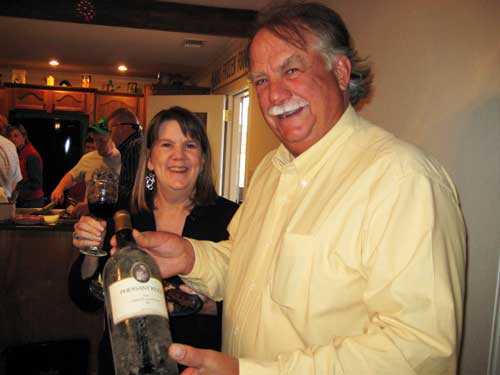
Best of VintageTexas: 2009 Highlights (so far)
Drinking a Bit of Texas History
“As Texans and settler transplants have realized for over the past hundred and fifty years, parts of Texas have been this county’s last frontier. Its empty landscape first attracted cattle drives, ranches and eventually farmsteads to this desolate and, at times, hostile place. Eventually, seemingly simple yet significant innovations like windmills and barbed wire helped make the Texas High Plains into an agricultural powerhouse. The Newsoms, Binghams, Reddys, Wilmeths, Tallants, Martins, Youngs and others are the pioneer families; the experimenting vinicultures that are reaching out to clutch the future of Texas grape growing. With each year, a new lesson is learned, a small change is made, and a new varietal is planted. When proven, these new lessons won’t be hoarded, but rather will be shared in the same communal spirit that was very apparent around the dinner table.”
More at: https://vintagetexas.com/?p=656
Sienna Sip and Stroll: Pinot Gringos and All Their “Trick Wines”
This man asked John Bratcher if the wines he was pouring were “trick wines”. John stopped and was taken aback, but then asked the man what he meant by his term ‘trick wines’. The man then responded by saying, “You know….those trick wines that are made by blending different grapes together rather than using just one grape type.” By this time John was really perplexed and responded, “Unless you are talking about German Rieslings or French Burgundies, just about all other wines are made from a blends of grapes. John proceeded to rattle off a list that included just about every wine producing region of the world, including greats like Bordeaux and the Rhone Valley in France, Rioja in Spain, and Tuscany in Italy. The panelist agreed that we should let’m bring on the ‘trick wines” in Texas, too!
More at: https://vintagetexas.com/?p=748
From the Mediterranean Shores to Mason County Texas: Act II – Seeing, Tasting and Praying for Terroir
We headed west on Route 290 from Fredericksburg and, within minutes, the limestone road cuts at the eroded edge of the Edwards Plateau started to fall away. The countryside morphed into outcroppings of even more ancient, burnt-orange “Hickory” sandstone with a magnificent view of the Llano Basin open before me. The meeting of water on rock in Mason County is there, available to the beholder; a visible slice of geological time over 500 million years that produced a very particular ‘terres de la vigne’. The basin and its Hickory Sands were crafted by local uplift and subsequent erosion first removing the limestone overburden and, in more recent times, eating still further down into the older, now-exposed sandstone. This process produced a mineral-rich sandy soil and left isolated limestone-topped mesas to dot the landscape, a scene similar to one I experienced in Bandol in southern France.
More at: https://vintagetexas.com/?p=622
North Texas Road Trip: Entry 6 – Lone Oak Vineyard, a Bit of Texas Bordeaux
“Over the period of a couple days since the cold and ice hit northeast Texas, the weather was warming agreeably. Saturday raised its fresh and sunny face. The morning sun cast a warm, amber hue on the dry countryside punctuated only by occasional fields of emerald green winter rye. Robert Wolf and I talked about his fifteen plus year experience at Lone Oak Vineyard and his efforts to develop Bordeaux-style wines. In our discussion, Robert and I immediately focused on additional elements of terroir beyond soil as a key to the vineyards success. The vineyard’s proximity to Lake Ray Roberts was apparent.”
More at: https://vintagetexas.com/?p=521
Winemaking Starts in Texas:
A Retrospective “Tasting” with Father Garcia de San Francisco y Zuniga
When I finished the pour of Mission wine, Father Garcia picked up his glass and slowly raised it in anticipation of his first taste of wine in almost 350 years. Before tasting, he gave it an appreciative stare and then met me with a gaze that seemed to linger a full minute or more. He then said, “This wine is so red, just like the color of the ripe grapes on the vine. As I smell the wine, the aroma is so light and delicate like I have never experienced in our sacramental wines.”
More at: https://vintagetexas.com/?p=458
Terroir: A “Land – Man” Conjunction
The scenery was dominated by red-brown dirt and sky that gives me the feeling that I was viewing the land that was created very early on the morning of third day of creation. This was before God had yet worked up the idea of making high mountain vistas on the newly created land. I also had the impression that this was a very special place….land made of natural elements but where uniquely human elements of grit and determination had been applied. This region was first used for open range cattle grazing. “New technologies” – barbed wire and windmills – first looked at with suspicion, led to improved herds and eventually sustained the region’s agriculture boom of corn, cotton, and soybeans. We are now in the offing of a potentially new boom time….for wine grapes.
More at: https://vintagetexas.com/?p=387

Be the first to comment